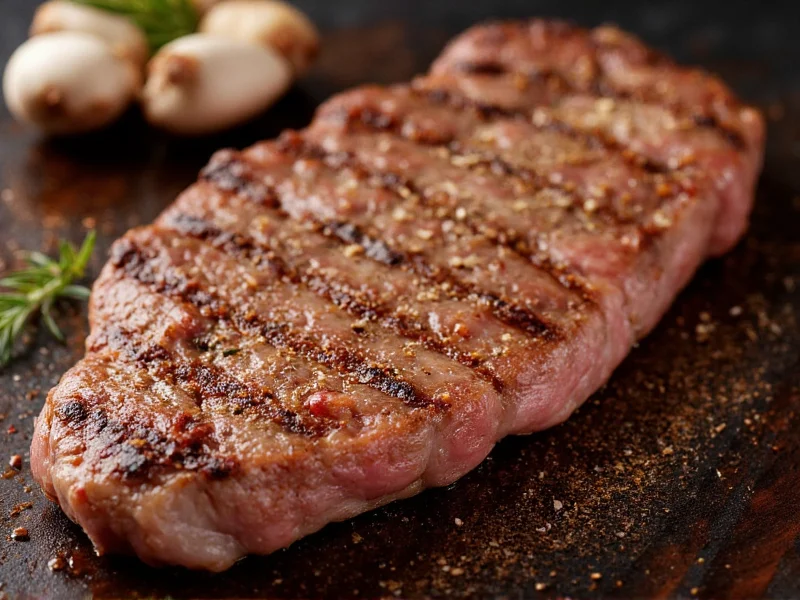The timeless question of the best seasoning on steak has a surprisingly straightforward answer that professional chefs and culinary experts consistently endorse. While complex spice blends abound, the foundation of exceptional steak seasoning remains remarkably simple: high-quality salt and freshly ground black pepper. This pairing works because it enhances rather than masks the natural umami-rich flavor of quality beef. The science behind this simplicity lies in how salt draws out moisture initially, then helps form a flavorful crust during the Maillard reaction, while pepper adds aromatic complexity without overwhelming the meat's inherent taste.
Why Salt and Pepper Reign Supreme
Understanding why salt and pepper form the ideal steak seasoning requires examining their complementary roles in flavor development. Salt isn't merely a flavor enhancer—it fundamentally changes the protein structure of meat, allowing it to retain more moisture during cooking. When applied properly (typically 40-60 minutes before cooking for thicker cuts), salt dissolves, penetrates the meat slightly, and then gets reabsorbed, seasoning from within rather than just on the surface.
Black pepper, particularly when freshly cracked, provides volatile aromatic compounds that complement beef's natural flavors without competing with them. The piperine in pepper creates a subtle heat that enhances perception of other flavors, making the beef taste more robust and complex.
Choosing the Right Salt for Steak
Not all salts perform equally when seasoning steak. The crystal structure and density significantly impact how the salt interacts with the meat:
| Type of Salt | Best For | Application Tip |
|---|---|---|
| Kosher salt (Diamond Crystal) | Most steaks, especially thicker cuts | Use 1 teaspoon per pound; apply 40-60 minutes pre-cooking |
| Sea salt flakes | Finishing touch after cooking | Sprinkle Maldon or similar flakes just before serving |
| Cooking-grade sea salt | When kosher salt unavailable | Use 25% less than kosher salt due to higher density |
| Table salt | Avoid for primary seasoning | Too fine; difficult to control application and can over-salt |
Pepper Selection and Application Techniques
The timing of pepper application matters significantly. Unlike salt, pepper can burn when exposed to high heat for extended periods, developing bitter compounds. For best results, apply freshly cracked black pepper just before cooking or during the last few minutes of cooking. This preserves its aromatic complexity while allowing enough time for the flavors to meld with the meat.
When selecting pepper, opt for whole peppercorns and grind them yourself. Pre-ground pepper loses its volatile aromatic compounds quickly. Tellicherry peppercorns offer a more complex flavor profile with less heat than standard black peppercorns, making them particularly well-suited for steak seasoning.
When to Consider Additional Seasonings
While salt and pepper form the essential foundation, certain situations warrant additional seasonings. These additions should complement rather than dominate the beef flavor:
- Garlic powder (not fresh garlic, which burns): Use sparingly (1/4 teaspoon per pound) for subtle background notes
- Onion powder: Similar application to garlic powder for added depth
- Smoked paprika: A pinch adds complexity without heat, particularly effective with grilled steaks
- Dried thyme or rosemary: Use very sparingly (1/8 teaspoon per pound) for special occasions
Important: Never use pre-mixed steak seasonings containing sugar when planning to achieve a proper sear. Sugar caramelizes at lower temperatures than needed for optimal Maillard reaction, leading to premature browning and potentially burnt flavors.
Seasoning Timing: The Critical Factor
The timing of salt application dramatically affects your steak's texture and flavor development:
- Thin cuts (under 1 inch): Salt immediately before cooking to prevent excessive moisture draw-out
- Thick cuts (1 inch or more): Salt 40-60 minutes before cooking, uncovered in the refrigerator
- Very thick cuts (1.5 inches+): Salt up to 24 hours in advance for maximum flavor penetration
- Pepper: Always apply just before cooking or during the final minutes to prevent burning
This timing strategy allows salt to penetrate the meat while giving surface moisture time to evaporate, creating ideal conditions for crust formation without steaming the steak.
Avoiding Common Steak Seasoning Mistakes
Even experienced cooks make seasoning errors that compromise steak quality:
- Mistake: Using iodized table salt - Solution: Switch to kosher or sea salt for better control and flavor
- Mistake: Adding pepper too early - Solution: Wait until just before cooking to preserve aromatic compounds
- Mistake: Seasoning immediately before high-heat cooking without drying surface - Solution: Pat steak dry after seasoning
- Mistake: Using wet marinades as primary seasoning - Solution: Save marinades for tougher cuts; use dry seasoning for premium steaks
- Mistake: Overcomplicating with too many spices - Solution: Remember that quality beef needs minimal enhancement
Special Considerations for Different Cuts
While the salt-and-pepper foundation works universally, certain cuts benefit from slight variations:
- Ribeye and Porterhouse: Can handle slightly more aggressive seasoning due to higher fat content
- Filet Mignon: Use slightly less salt as its delicate flavor can be overwhelmed
- Flank and Skirt steaks: Benefit from additional garlic powder and citrus zest for brighter flavor profile
- Wagyu and other premium marbled beef: Often best with minimal seasoning—just high-quality salt
Remember that the better the quality of your beef, the less seasoning it actually needs. Exceptional grass-fed or dry-aged steaks often shine with nothing more than properly applied salt.











 浙公网安备
33010002000092号
浙公网安备
33010002000092号 浙B2-20120091-4
浙B2-20120091-4